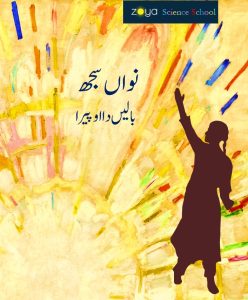Nawan Sij. A rock opera for children–the book:
A Young Girl. A Burning Question. A Fight for Nawan Sij
In The Opera, our heroine longs to know how big the Earth is—its circumference―and finds out at Zoya Science School. Her journey is one of courage and discovery: facing off those who want to drag her back several centuries, learning math and science, and proving her brilliance. Set to a vibrant mix of local, pop, and Western classical music, the opera is performed by villagers and children—voices from the very heart of the story.
Following ancient Greek drama, the Opera begins with a prologue: a chorus of villagers—vox populi—calling for Nawan Sij to spread the light of education for all (page 1)
A Mother’s Lament. A Daughter’s Call
The next scene brings a haunting solo—a mother’s song of sorrow, triggered by her daughter’s innocent question: How big is the Earth? (Pages 5–10). Echoing Maya Angelou’s Woman’s Work, it’s a cry from the heart of every woman who has labor and perish in silence, her life sacrificed on the altar of ignorance. “How would I know how big the Earth is?” she sings. “I’ve children to tend, clothes to mend, cane to cut, animals to feed…”
But this story does not end in despair. In the next song (Pages 11–12), the daughter rises. Her voice is full of hope: “Wake up!” she calls. “End this long night. Send your children to Zoya Science School.”
The Journey Begins. Knowledge Awakened. A Village Transformed.
And off she goes—singing with joy:
“I’m going to Zoya Science School. I will learn how big the Earth is!” (Pages 13–14)
At school, she dives into the world of science—learning through lively songs that make abstract ideas come alive (Pages 15–19). She sings of Pythagorous Theorem (Pages 20–23), circles and Pi (Pages 24–29), and heliocentrism (Pages 30–31)—building toward the great question she began with. She learns how Eratosthenes and Al-Biruni measured the Earth (Pages 32–37)—and now, so can she.
Then comes the crescendo (Pages 38–39). To Beethoven’s Ode to Joy, our heroine sings triumphantly:
“I have learned how big the Earth is! Its circumference is 40,000 kilometers!”
The village chorus returns for the finale (Pages 40–45), inspired by her triumph.
They rise together, singing: “We will raise Nawan Sij! Our children shall shape the country’s destiny—
No more tending the rich man’s animals!
We are sending our children to Zoya Science Schools.”
The Book’s Cover: Nawan Sij–A Symbolic Dawn
The book’s cover features a radiant Nawan Sij (from Edvard Munch’s The Sun)—a powerful emblem of life, creativity, and hope. It symbolizes the outburst of hope that Zoya Science Schools give to the children. And the school’s name Zoya, which traces back to Zeus/Dyaus Pitar of Aryan-Greek-Indian mythologies—meaning the “heavenly light of wisdom.”
From this sun emerges our heroine—like Athena from the head of Zeus—embodying knowledge, courage, and the promise of a brighter future. She leads forward like a local Lady Liberty—her silhouette drawn from Delacroix’s Liberty Leading the People, her dress rooted in village tradition, her outstretched arm from a Soviet WWII poster, and her face from a youthful Brooke Shields in her iconic debut.

